
22. TELEGRAPH COMPANY STAMPS
Several of the domestic telegraph companies issued adhesive franks or
stamps to apply to their message forms to indicate prepayment. This
page gives a brief, illustrated summary of the franks issued between
1854 and 1868.
The currency used here is the pound sterling, the '£' or 'L', then divided into twenty shillings, the 's', each of twelve pence, the 'd'. So the pound equalled 240 pence. Average individual male earnings in this period were about £24 per year. The nationwide postage for a letter was 1d. As regards technology, the use of the word "printed" in this page refers to reproduction from an engraved metal plate; "lithography" to reproduction from stone, a cheaper, less detailed process.
Telegraph company stamps are relatively rare as the forms they franked were handed back to the company when the message was sent, and ultimately pulped. Survivors with so-called "control numbers" (imitating numbers on banknotes) were kept by purchasers as souvenirs when the government took over; those without numbers had been disposed of by the companies as waste after 1868. Several companies used inked-rubber "obliterating stamps" to ensure that franks they received on their forms could not be re-used.
The Electric Telegraph Company issued "Franked Message Paper" at the Great Exhibition in London during 1851. This was a pre-paid message form and had a fixed price of 1s 0d for a twenty word message within a 50 mile radius of the sending station. It was 8¾ inches by 7¼ inches printed on pink, watermarked paper, embossed with the Company seal. They carried consecutive numbers and were issued between 1851 and 1854.
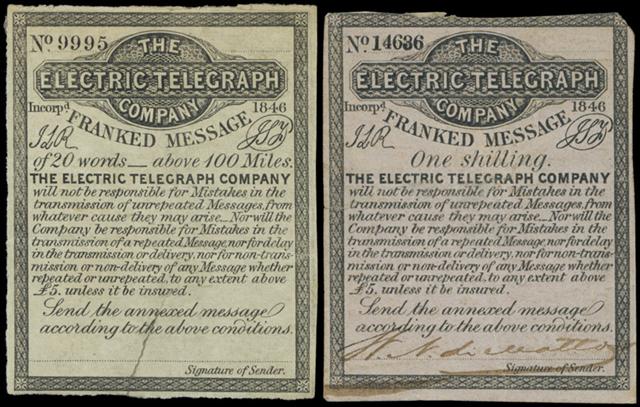
Electric Telegraph Company 1854
First Stamp
On
June 1, 1854 the Electric company introduced the first telegraph stamp,
which it termed a "Franked Message". This was adhesive-backed, 2⅝
inches by 2 inches in size on sheets of sixteen franks, and contained a
brief summary of the Company's terms. There were three "denominations",
for messages of twenty words under 50 miles, on pink paper; under 100
miles, on deep-blue paper; and over 100 miles, on white paper. The
sender had to sign the stamp face to show they knew the Company's
terms, this meant that these large stamps could frank plain paper as
well as the message forms. They were produced by Perkins, Bacon &
Company, steel engravers, banknote and stamp printers, of 69 Fleet
Street, London. They were not perforated.
As with most subsequent telegraph franks they are "signed" in facsimile by company officials. In this case the initials JLR for J Lewis Ricardo, and JSF for James Sealy Fourdrinier, chairman and secretary respectively, appear in the top corners. They were the first stamps overprinted with consecutive numbers.
Second Stamp
In
January 1855 the "denomination" was altered from mileage to value to
make them more flexible in accounting for distance and wordage. The
design was kept the same but extended: 3d on light yellow paper; 1s 0d
on fawn paper; 1s 6d on pink paper; 2s 0d on light blue paper, 3 s 0d
on deep blue paper; and 4 s 0d on white paper. These were also made by
Perkins, Bacon & Company. Until 1860 they were not perforated, in
June of that year Perkins Bacon acquired a perforator, these were the
first stamps it was used on.

In 1861, after competitive companies introduced "postage stamp sized" franks, the Electric replaced its large "Franked Message" version with small "Telegraph Stamps". There were two sorts; one for inland messages, portrait format, and one for continental messages, landscape format. They were all made by Waterlow & Sons, 66 London Wall, London, lithographers. The Telegraph Stamps were perforated. They were like as not printed on sheets of 100, 10 by 10, as were most of Waterlow's franks.
The inland Telegraph Stamps were 1¼ inches by 1 inch in size, perforated and numbered. They carried the year 1861, which never changed. They were lithographed on white paper in coloured ink: 3d ochre-brown; 1s 0d orange-yellow, 1s 6d rose-pink, 2s 0d green; 2s 6d chocolate-brown; 3s 0d blue, 4 s 0d black, 5s 0d purple and 10s 0d in purple-brown. All were consecutively numbered. Each stamp was "signed" or initialled by the Chairman Robert Grimston (RG) and the Secretary, James Sealy Fourdrinier (JSF) in facsimile.
The Continental Stamps were issued in denominations of 3d, 1s 6d, 4s 0d and 8s 0d, lithographed in black to a size 1 inch by 1⅜ inches, overprinted with consecutive numbers. These were not "signed" but had the initials of the chairman (RG) and secretary (JSF) printed in small cyphers either side of the price. They carried the unchanging 1861 date in the corners.
The
Continental Stamps were abandoned before 1864, when Henry Weaver became
secretary, and replaced by high value inland Telegraph Stamps.
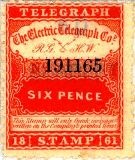
Early in 1864, the "signatories" on the Inland design were altered to RG, Robert Grimston, and HW, Henry Weaver, and a new denomination added, 6d in bright-vermillion ink, especially for use within London and provincial cities.
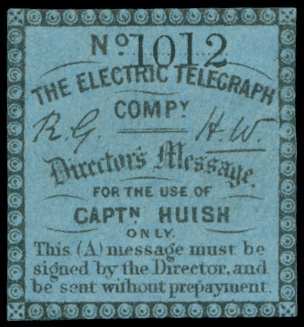
For a period the Company issued its directors with a private series of adhesive stamps for attachment to the ordinary message form. They appear to date from 1855 until the mid 1860s when Director's Passes were introduced. Each director was issued with stamps carrying his name and numbered in sequence. The stamps, of a size 1 inch by 1⅛ inches, were lithographed in black ink on blue paper. It is not known if these were "free" messages or had to be accounted for. They were not perforated.
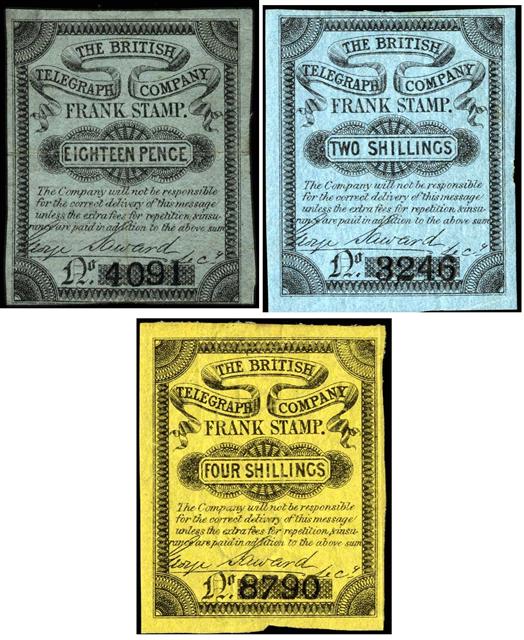
The "Frank Stamps" of the British Telegraph Company are rare and slightly mysterious. They were missed by the authors of the first history of telegraph stamps. Existing samples have values of 1s 6d printed black on grey paper, 2s 0d, printed black on blue paper and 4s 0d printed black on yellow paper, to a size of 2⅜ inches by 1⅞ inches. Sheets of thirty-two stamps were watermarked with the Company title. They are "signed" in facsimile by George Saward, the secretary. They were not perforated.
These franks were lithographed by Mawdesley & Company, 2 Castle Street, Liverpool.
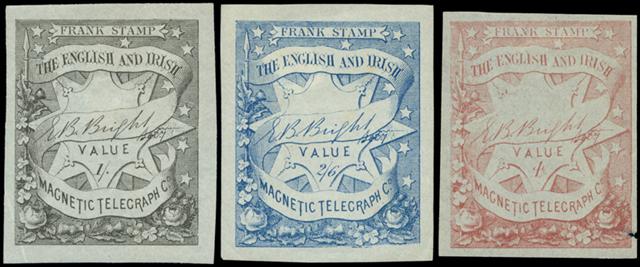
The English & Irish Magnetic Telegraph Company c 1854
It
is claimed that the Magnetic company issued its first "Frank Stamp" for
messages in 1853. It is more likely that they appeared sometime in 1854
or 55, as there is no notice of them given in their published
works of 1854. There were five denominations identical in design
and size, 1¾ inches by 1⅜ inches, except for the value and ink colour:
1s 0d in black, 1s 6d in lilac, 2s 6d in blue, 4s 0d in pale red and 5s
0d in green, all on white stock. The green 5s 0d stamp covered,
appropriately, a twenty word message to Ireland. The stamps were
"signed" in facsimile by the secretary E B (Edward Brailsford) Bright, and overprinted in
black with control numbers. They were not perforated.
They were made by Mawdesley & Company, lithographers, of 2 Castle Street, Liverpool.
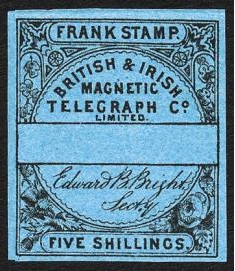
The British & Irish Magnetic Telegraph Company 1857
Mawdesley’s lithographed a new series of
“Frank Stamps” for the combined Magnetic and British companies in 1857. These
were to a size 1⅛ inches by 1 inch printed in black on coloured paper to a
simple design. There were a wide variety of denominations: 3d on white, 6d on
flesh, 1s 0d on lavender, 1s 6d on grey, 2s 0d on bright yellow, 2s 6d on pale
olive yellow, 3s 0d on pink, 4s 0d on pale green and 5s 0d on pale blue. The
facsimile “signature” was now spelled out as ‘Edward B Bright, Secty’. This
series was perforated.
There was an early version with an even
simpler surface design, of which only one example exists. This had the price in a central box prefixed
by the word ‘Value’.
The paper sheets of the earliest franks
of the British & Irish company retain the watermark of its component, the
British Telegraph Company.
As noted, they were made by Mawdesley
& Company, 2 Castle Street, Liverpool.
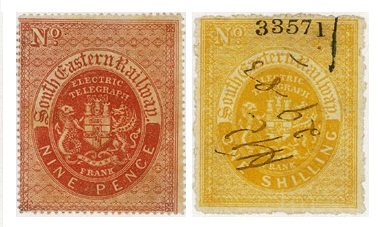
In September 1860 the South Eastern Railway, then the third largest telegraph network in Britain, began to issue "Electric Telegraph Franks". These were made to a common, very handsome design by Charles Whiting, Beaufort House, Strand, London, and printed to a size 1⅝ inches by 1 ⅜ inches. The denominations were 9d in red on white paper, 1s 0d in orange-yellow on white paper, 1s 2d in black, 1s 6d in lilac, 2s 3d in red-brown and 2s 9d in green. They were watermarked SER and perforated. Although only 25,000 were printed they were in use until 1868.
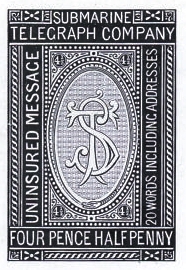
The Submarine company introduced "Uninsured Message" franks in November 1861 in five denominations: 4½ d, 3s 9d, 4s 0d, 7s 6d and 8s 0d. These unusual values are explained by the flat rates that the Company had adopted: 3s 9d for a ten word message to Denmark, and 4s 0d for a ten word message to the German states, on its new cables, 4s 0d also was the price of a message to France; the double values for messages of twenty words. The 4½d stamp was for each additional word.
The value was spelled out at the base and rendered in tiny numbers in the four corners of a central STC monogram panel.
The Submarine company stamps were of identical design except
for the value, of a size 1⅝ inches by ⅞ inches, finely printed in mauve
on white paper by De la Rue & Company, 110 Bunhill Row, London.
They were perforated and printed 80 per sheet. Most unusually for
British telegraph franks, they were not consecutively numbered.
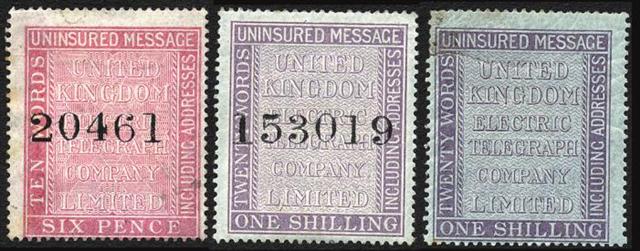
The United Kingdom Electric Telegraph Company 1862
First Stamp
The
United Kingdom company first issued "Uninsured Message" franks
in December 1861, when the spine of its network between London,
Birmingham, Manchester and Liverpool was near opening. Its stamp issue
ought to have been straightforward in that it had a flat rate of 1s 0d
for a twenty word message whatever the distance.
They were made by De la Rue & Company, 110 Bunhhill Row, London, and printed on white paper to a size 1⅛ inches by 1 inch. There were, in fact, three denominations: 3d in yellow-ochre, 6d in pink and the widely-used 1s 0d in violet. In size and quality they were close to the high-value 5s 0d postal stamps, so close in fact that the earliest United Kingdom franks were printed on blue-tinged security paper. The 3d and 6d stamps were to account for five and ten extra words respectively. All were perforated
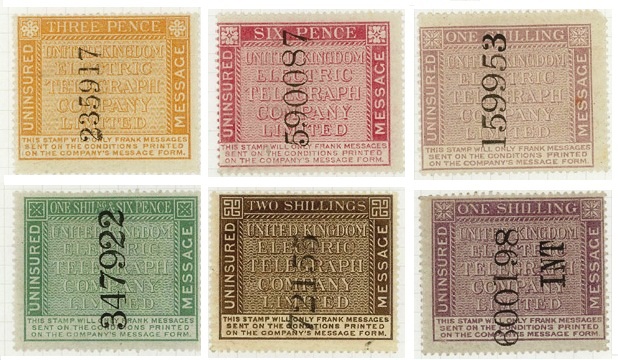
In July 1864 the design of the United Kingdom's franks was altered to a landscape format of the same size, new values were introduced and the quality of the reproduction reduced, later versions, particularly of the 1s 0d value, were lithographed rather than printed from metal, probably not by De la Rue.
There were then 3d stamps in orange-yellow, 6d in rose, 1s 0d in violet, 1s 6d in green and 2s 0d in brown, on white paper. The upper corners of each value contained a unique cipher. The Company abandoned the 1s 0d flat rate in July 1865.
Franks used to pay interest on its 7½ % Bonds were overprinted INT in black.

The London District Telegraph Company 1862
The District company in metropolitan London made immense promotional
use of its stamps. It offered them bound in booklets, six stamps to a
"page", and for sale in bulk at a discounted price for most of its
existence. They were all lithographed by James Truscott & Sons,
Suffolk Lane, Cannon Street, London.
There were three denominations, 3d, 4d and 6d issued from 1862, notable for having the value appear in very large size. To a size 1⅛ inches by 1 inch, they were "signed" in facsimile by the then secretary A (Alfred) Ogan. The 3d stamp was lithographed in black on bright yellow paper, the 4d stamp on blue paper and the 6d on vermilion-faced paper. Uniquely the control numbers on the 3d and 4d issues were overprinted in red rather than the near universal black. They were perforated.
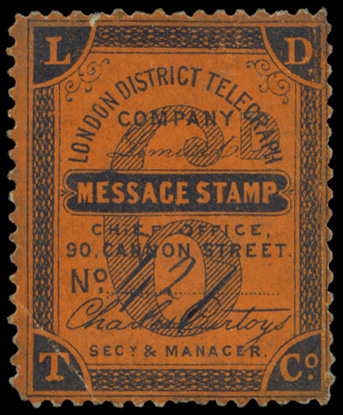
A new design was issued, apparently in 1865, but probably several years earlier, with the title "Message Stamp" and "signed" by the current secretary Charles Curtoys. As previously these were lithographed in black on coloured stock, and perforated, 1¼ inches by 1 inch. There were two denominations, 3d originally on yellow paper, and 6d originally on pink paper, with the control numbers overprinted in black. Later lithographs were on greenish-blue paper for 3d, and vermillion for 6d values, the control numbers entered in handwriting.
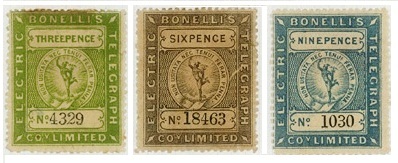
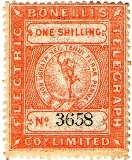
Bonelli's Electric Telegraph Company 1863
Bonelli's only worked one line, between Manchester and Liverpool, for a
very short period in 1863. They still, however, provided four
denominations of telegraph frank; 3d in bright green on white paper, 6d
in black, 9d in blue and 1s 0d in orange to the size 1¼ inches by 1 inch, lithographed
by Waterlow & Sons, 66 London Wall, London. They were perforated and printed on sheets 10 by 10.
Two booklets of stamps were also made for Bonelli's: 84 stamps in seven pages in a green paper cover, and 42 stamps in seven smaller pages in a pink paper cover, both using a reddish-brown version of the 3d stamp to a differing size 1⅜ inches by 1 inch.
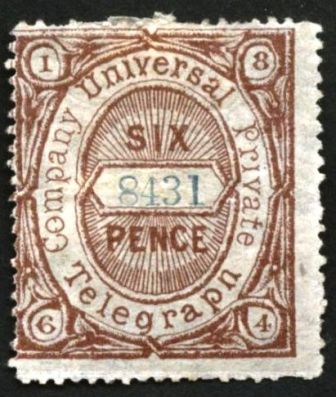
For the convenience of the customers on its public circuits in Western Scotland and North-East England the Universal company also adopted telegraph stamps during 1864. This year was carried in the corners of all the franks. They were lithographed by Waterlow & Sons, 66 London Wall, London, to a size 1¼ inches by 1⅛ inches, with coloured ink on white paper, one hundred to the sheet. There were two sorts, 6d in brown and 1s 0d in mauve, both were printed on sheets 10 by 10, and perforated.
This railway worked its own telegraphs and issued at least two sorts of "Stamps for Telegraphs". These were in the value of 3d lithographed in black on yellow paper and 1s 0d in black on grey-white paper. They carry the "signature" of J S (James Staats) Forbes, the General Manager. They were not perforated.
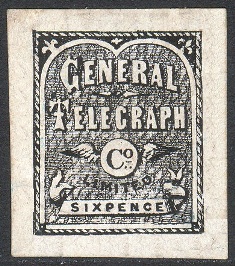
A 6d value perforated frank exists lithographed in black on white paper for this company. Possibly a fraud, it may be an issue of the General Private Telegraph Company of Manchester that offered the customers of retail traders "free" messages on its single circuit to Altrincham using franks.

Electric Telegraph Company delivery envelope 1861
Here for a message being forwarded by steamer to Valparaiso, Chile
from the port of Southampton, paid with postage stamps
please click this link to Steve Panting's new site
Telegraph Stamps of Great Britain
which deals with the neglected subject in considerable detail
The text of this page of Distant Writing is drawn in great part from
The Postage and Telegraph Stamps of Great Britain
by F A Philbrick and W A S Westoby,
published by Sampson Low, Marston, Searle & Rivington, London, in 1881;
with additional information from
Private Telegraph Companies of Great Britain and their Stamps
by Raymond Lister,
published by Golden Head, Cambridge, in 1961.
Thanks go to Grosvenor Auctioneers & Valuers for generously allowing use of their fine photographs of rare telegraph stamps
Grosvenor Auctions
399 – 401 Strand, London WC2R OLT
www.grosvenorauctions.com
Other stamp images are from the National Postal Museum collection
The black and white engravings of telegraph stamps used throughout Distant Writing are nineteenth century re-drawings of the originals and may not be entirely accurate
Telegraph, from the Greek “tele”, distant, and “graphos”, writing